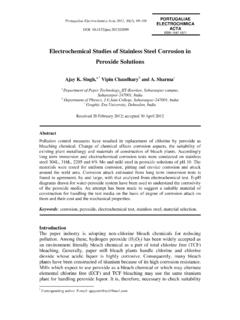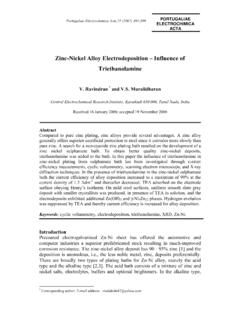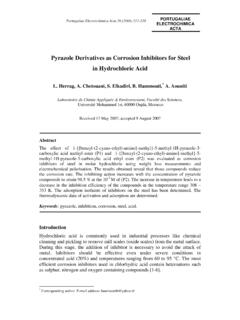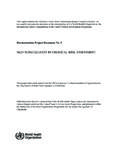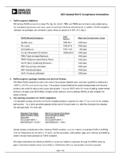Transcription of Corrosion Protection of Hot Dip Galvanized Steel …
1 Portugaliae Electrochimica Acta 2013, 31(5), 277-287 DOI: PORTUGALIAE ELECTROCHIMICA ACTA ISSN 1647-1571 Corrosion Protection of Hot Dip Galvanized Steel in Mortar Rita M. Figueira,a,b,* Elsa V. Pereira,a Carlos Silva,b Maria M. Saltaa a LNEC Laborat rio Nacional de Engenharia Civil, Lisboa, Portugal b Centro de Qu mica, Universidade do Minho, Braga, Portugal Received 31 July 2013; accepted 31 October 2013 Abstract Corrosion of Steel in concrete is one of the major causes of structure degradation, requiring expensive maintenance.
2 The using of hot dip Galvanized Steel (HDGS) has been recognized as one effective measure to increase the service life of reinforced concrete structures in marine environmental. However, HDGS corrodes in contact with high alkaline environment of fresh concrete. Although this initial Corrosion process allows the formation of a protecting layer barrier, the Corrosion that occurs initially is harmful and chromate conversion layers are usually used to prevent it. Due to toxicity of Cr(VI), these kinds of pre-treatments have been forbidden and hybrid coatings have been proposed as alternatives [1-3].
3 To evaluate the performance of these coatings, beyond the laboratory characterization, in situ tests in real conditions should be performed. An electrochemical system to measure the macrocell current density (igal) was designed to evaluate the degradation of HDGS coated samples with different organic-inorganic hybrid films, embedded in mortar during 70 days, using an automatic data acquisition system. This system revealed to be feasible and highly sensitive to coatings degradation. Also, allow distinguishing different hybrid coatings with different thicknesses.
4 Keywords: Corrosion ; Galvanized Steel , Protection , Gel coating, Sol-gel. Introduction To minimize the risk of Corrosion of reinforced concrete structures (RCS) it should be ensured that the concrete covering the metallic reinforcement parts is of an adequate thickness and possesses a high quality, with a proper mixing ratio, good compaction and curing. However, the physical barrier of Protection * Corresponding author. E-mail address: Figueira et al.
5 / Port. Electrochim. Acta 31 (2013) 277-287 278provided by the concrete cover is not perfect. Due to the porous concrete structure, resulting from imperfections of concreting and curing processes, the diffusion/transport of aggressive species towards the interface Steel /concrete is enabled. The conjugation of these factors may cause rupture of the film passivation and initiate rusting of Steel originating failure in reinforced concrete structures. However, premature failure in RCS by reinforcement Corrosion in aggressive environments, especially structures exposed to marine environments, might be mitigated if the reinforcing Steel is hot dip Galvanized [4-7].
6 The zinc coating on rebars embedded in concrete acts as a physical barrier avoiding direct contact between the coated reinforcing Steel and the aggressive environment. Deposited zinc acts as sacrificial anode protecting the Steel against Corrosion and the zinc Corrosion products provide a sealing effect on zinc coating due to discontinuities 0. Moreover, Galvanized reinforcing Steel can withstand exposure to chloride ion concentrations several times higher (at least 4 to 5 times) than the chloride level, that causes Corrosion in Steel reinforcement 0.
7 While Steel in concrete typically depassivates at a pH below , Galvanized reinforcement can remain passivated at a lower pH, thereby offering additional substantial Protection against the effects of concrete carbonation 0. The combination of these factors: carbonation resistance and chloride tolerance are commonly accepted as the basis for superior performance of Galvanized reinforcement compared to Steel reinforcement. In addition, zinc Corrosion products occupy a smaller volume than those produced from iron causing slight or no disruption in the surrounding concrete.
8 Yeomans 0 also confirmed that the zinc Corrosion products are powdery and non-adherent making them capable of migrating from the surface of the Galvanized reinforcement into the concrete matrix, reducing the likelihood of zinc Corrosion -induced spalling of the concrete. The cathodic reaction from water hydrolysis with hydrogen evolution, in contact with high alkaline environments, such as concrete, takes place, producing a continuous dissolution of the metal until the solution becomes oversaturated by these ions that precipitate as Zn(OH)2 or ZnO 0.
9 In order to avoid those reactions the cement must contains at least 100 ppm of chromates in the final concrete mix or the hot-dip Galvanized bars must be previously passivated with a chromate conversion layer to minimize the evolution of hydrogen during the reaction between zinc and fresh concrete [9-15]. The high Corrosion resistance offered by the use of chromate films is endorsed to the presence of Cr6+ and Cr3+. Chromate and similar hexavalent chromium compounds are among the most common substances used as inhibitors and are commonly incorporated in anticorrosive pre-treatments of a wide range of metals and alloys, such as steels, aluminium alloys, copper, lead and others.
10 The original reason behind the use of chromate treatments on Galvanized Steel is to avoid the formation of wet storage stain during the first six weeks after galvanizing, in particular to reduce the formation of excessive amounts of zinc oxide and zinc hydroxide during that period, and reduce the consequent release of hydrogen gas 0. The reaction of zinc with the concrete ceases in a few days and gives just Figueira et al. / Port. Electrochim. Acta 31 (2013) 277-287 279sufficient Corrosion products to ensure a strong and reliable bond to the concrete when fully hardened.
